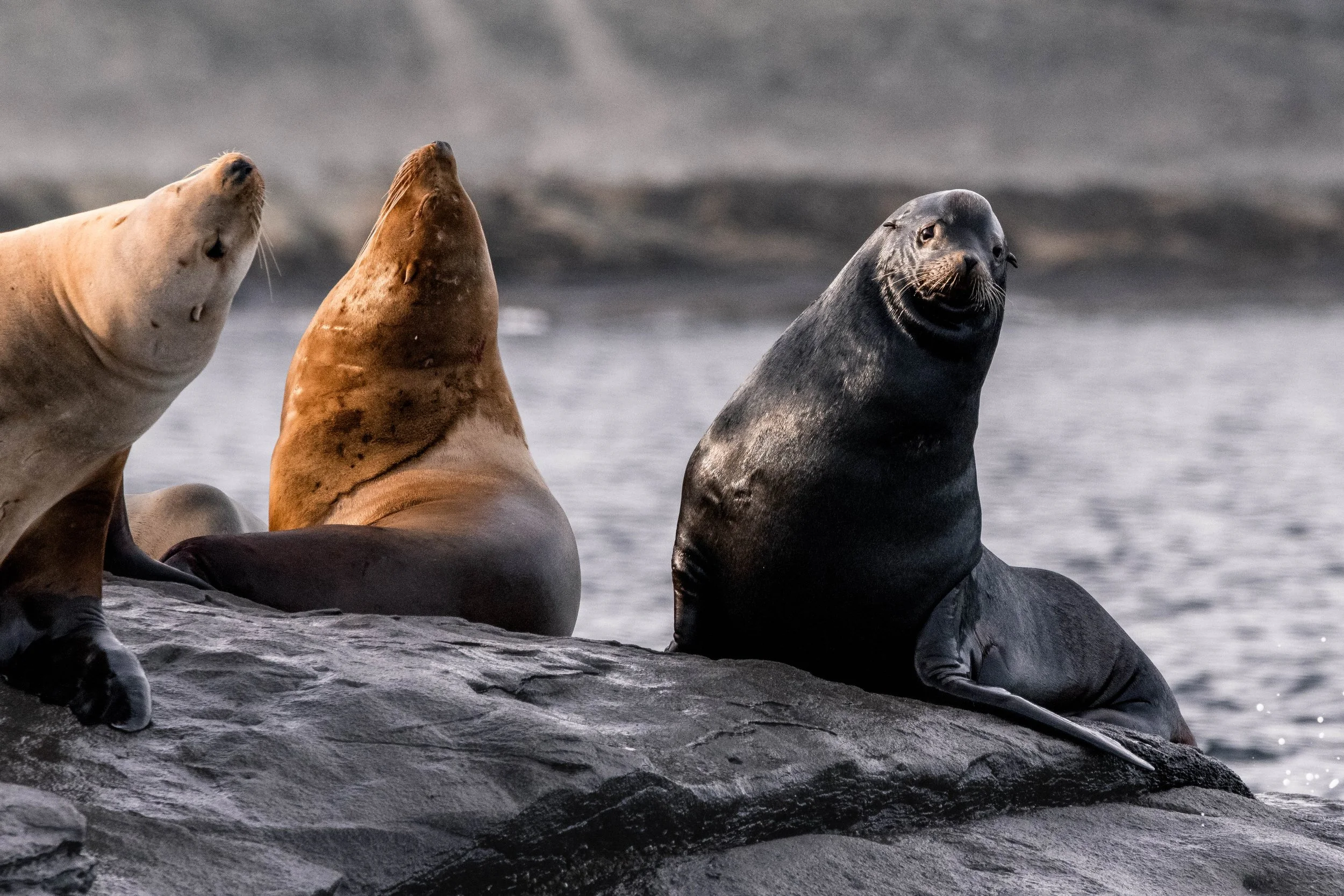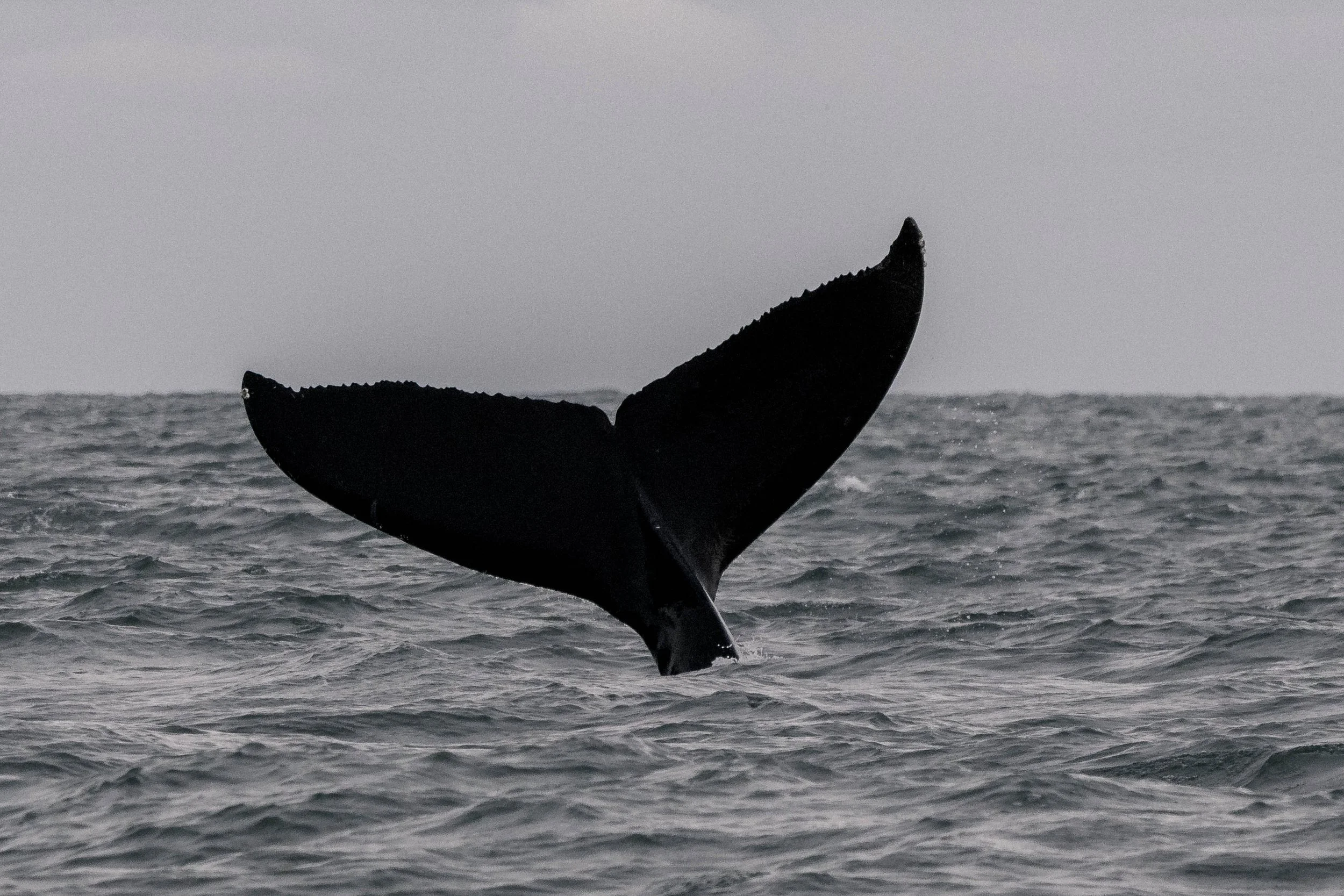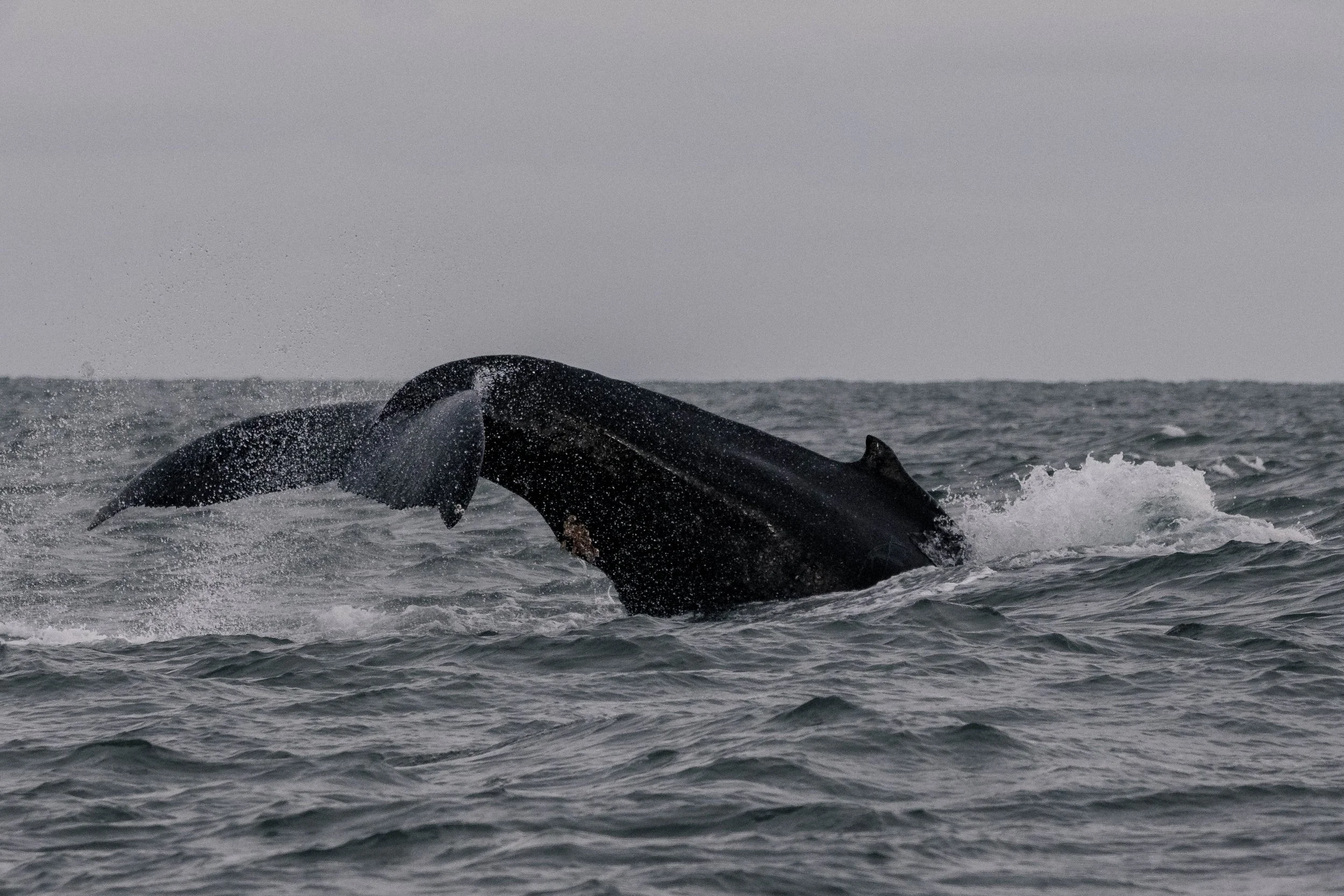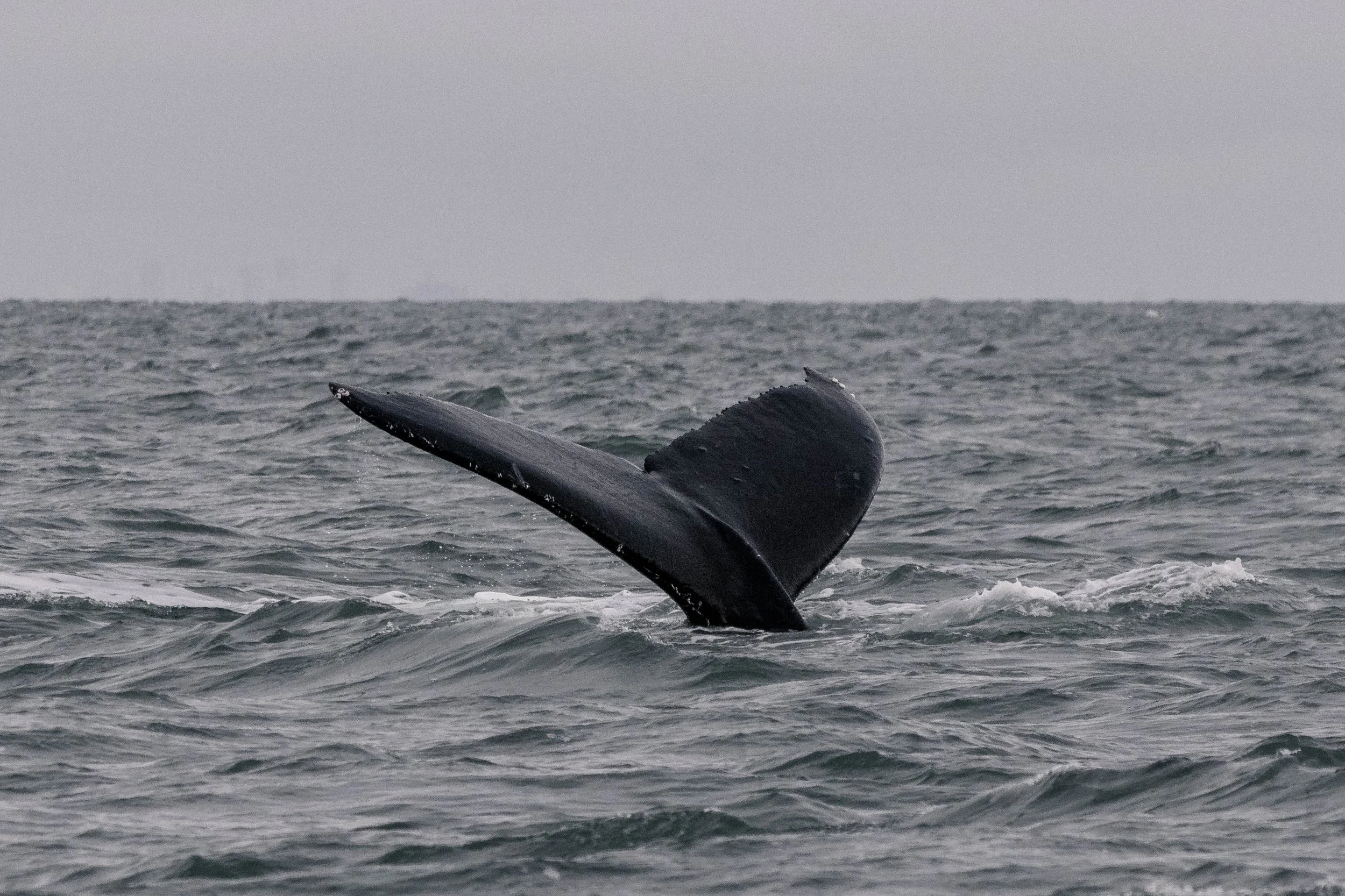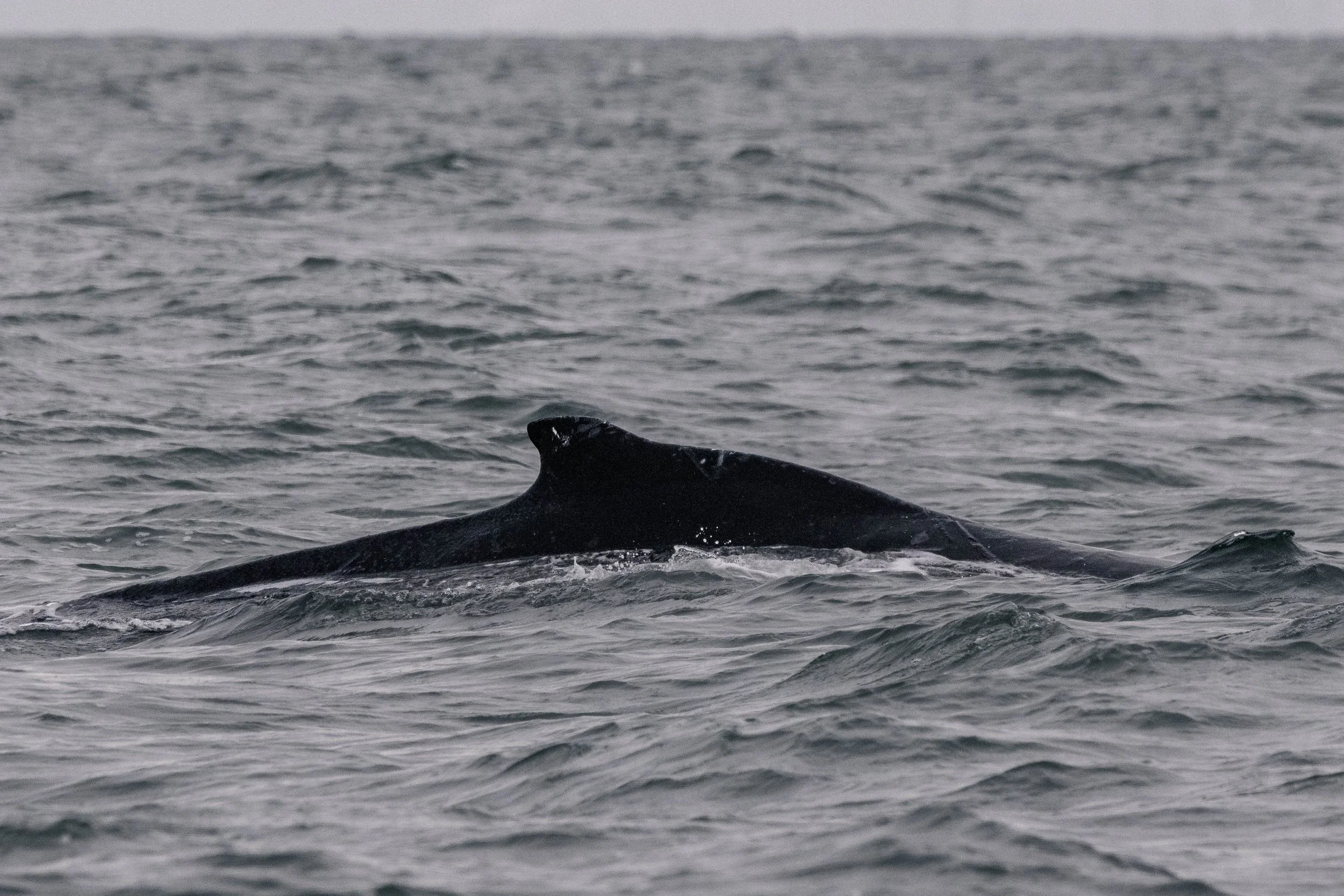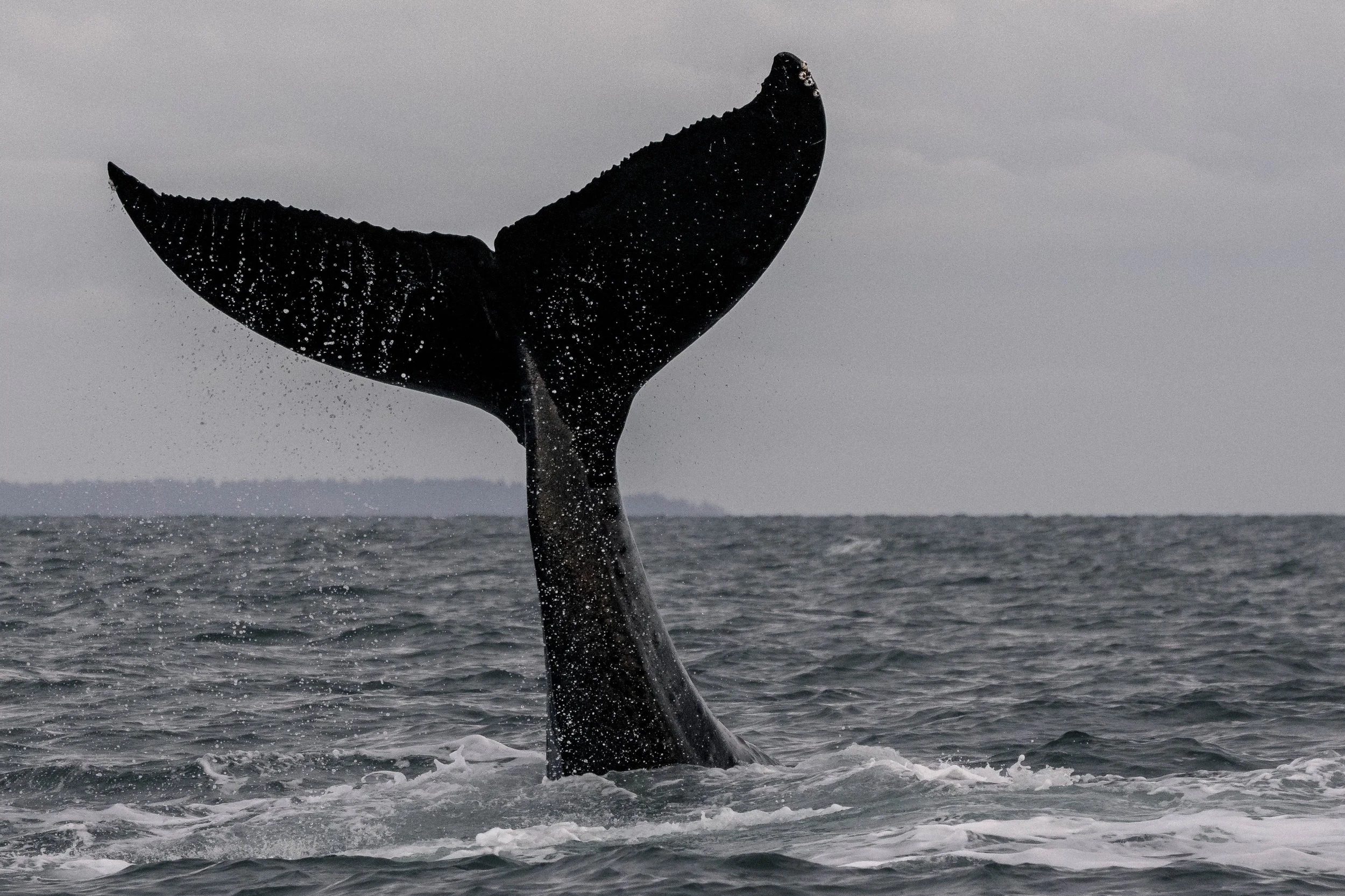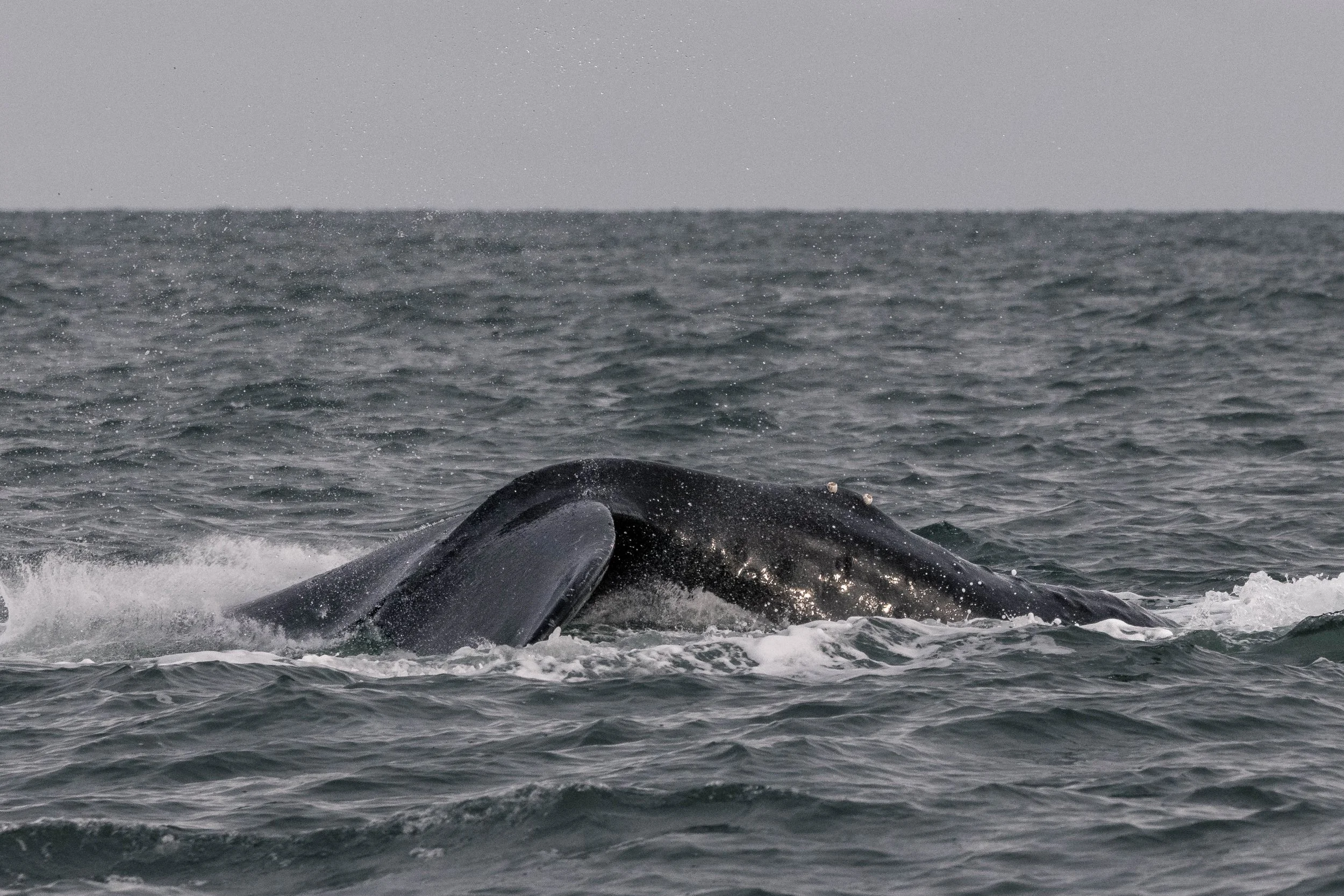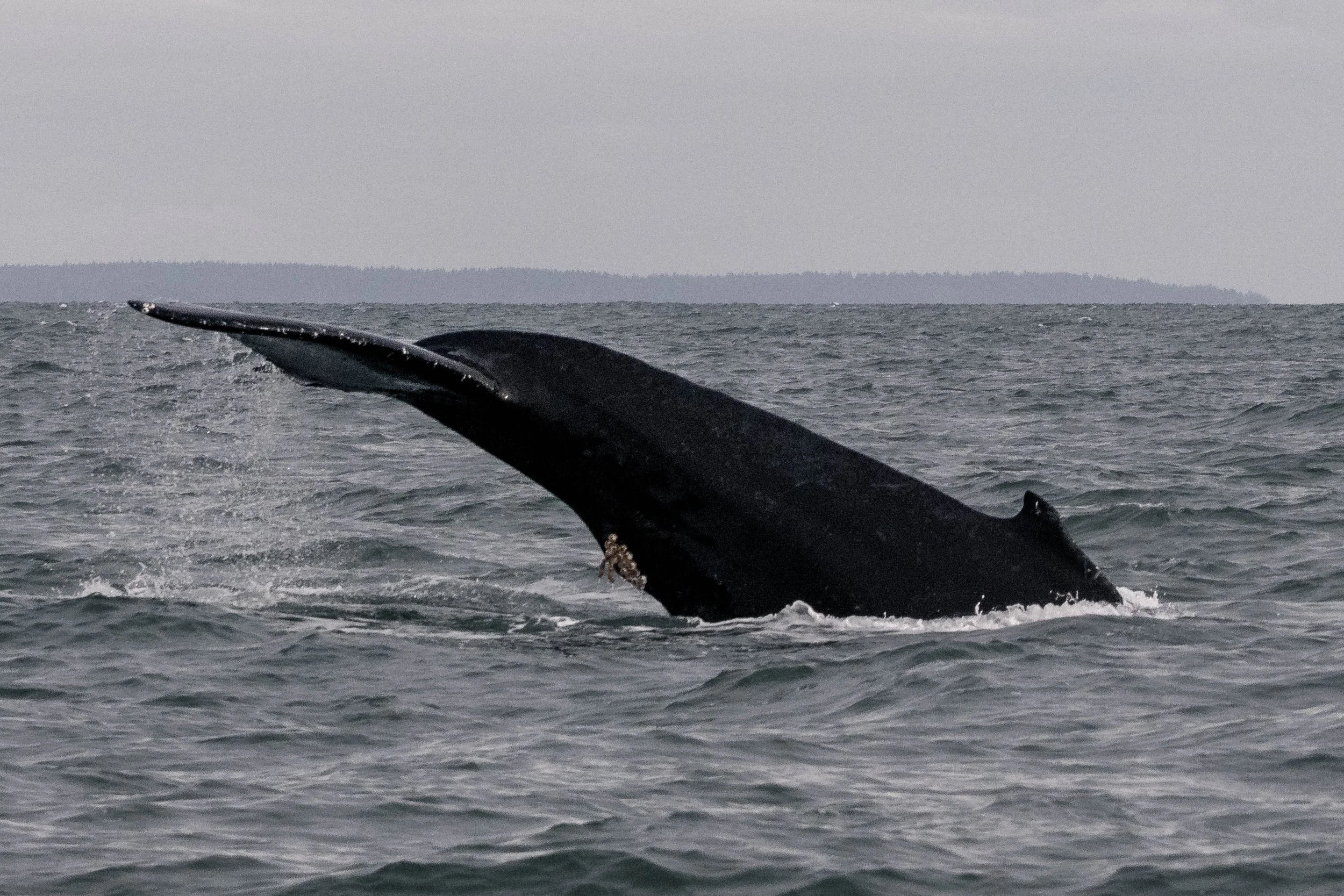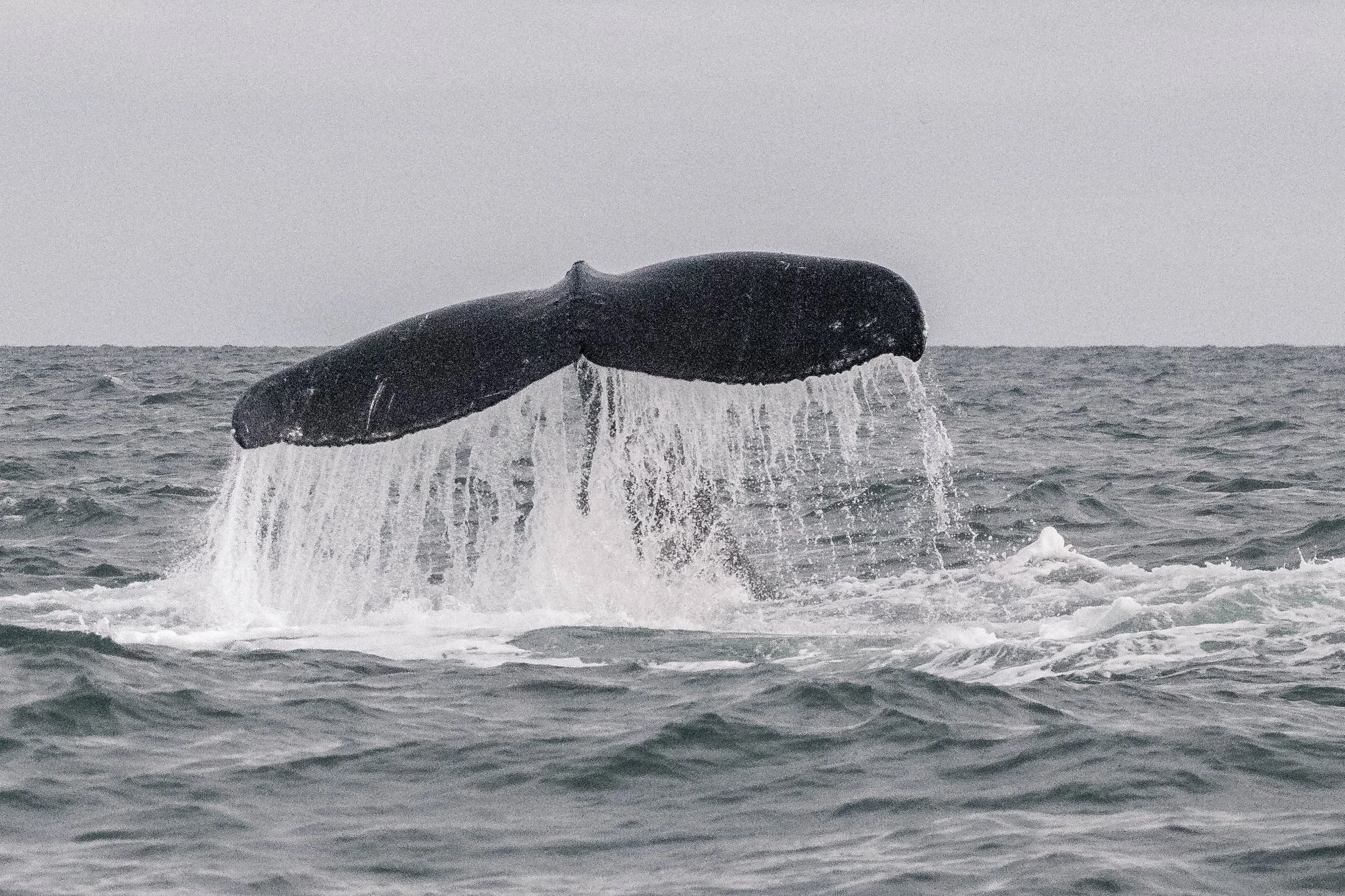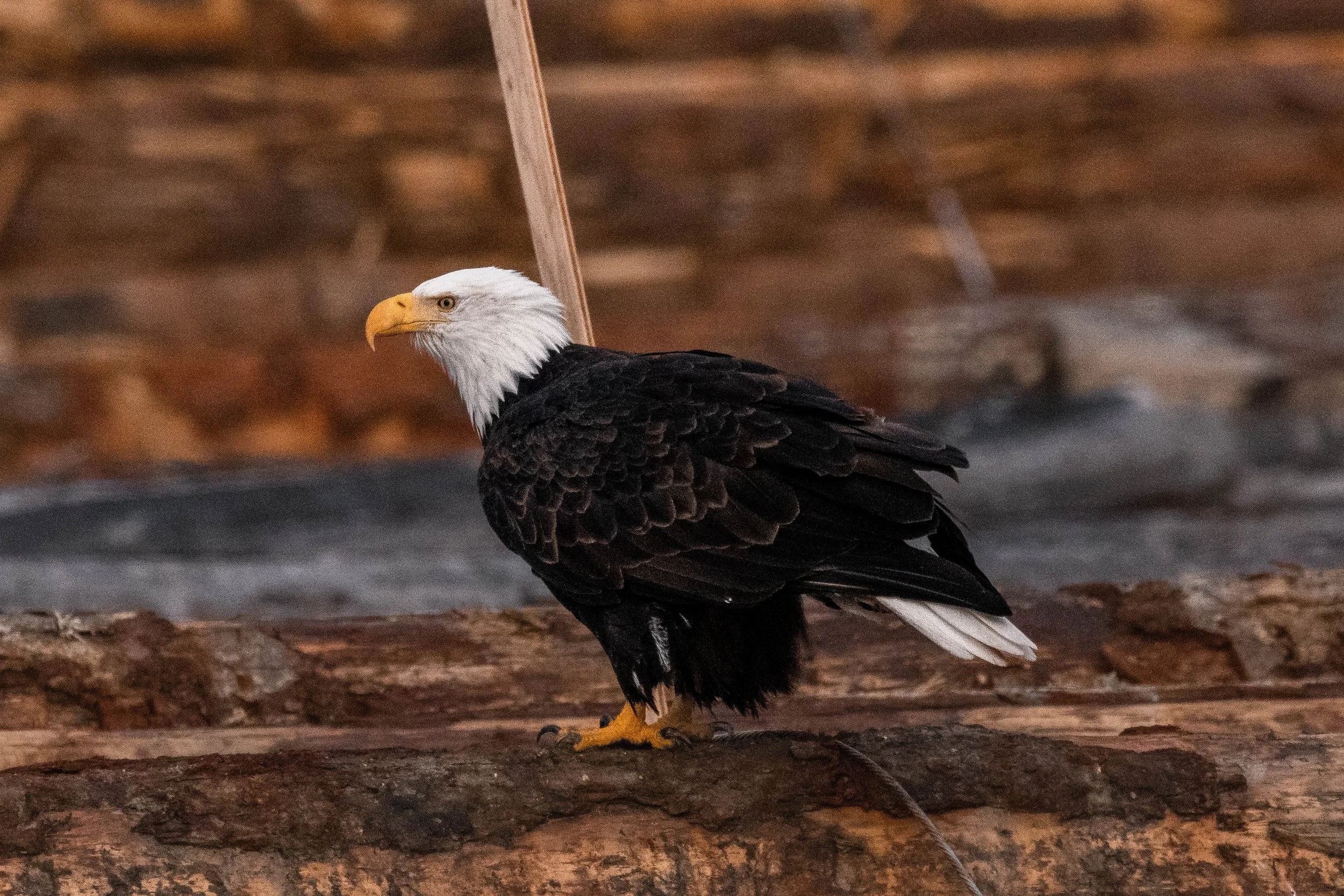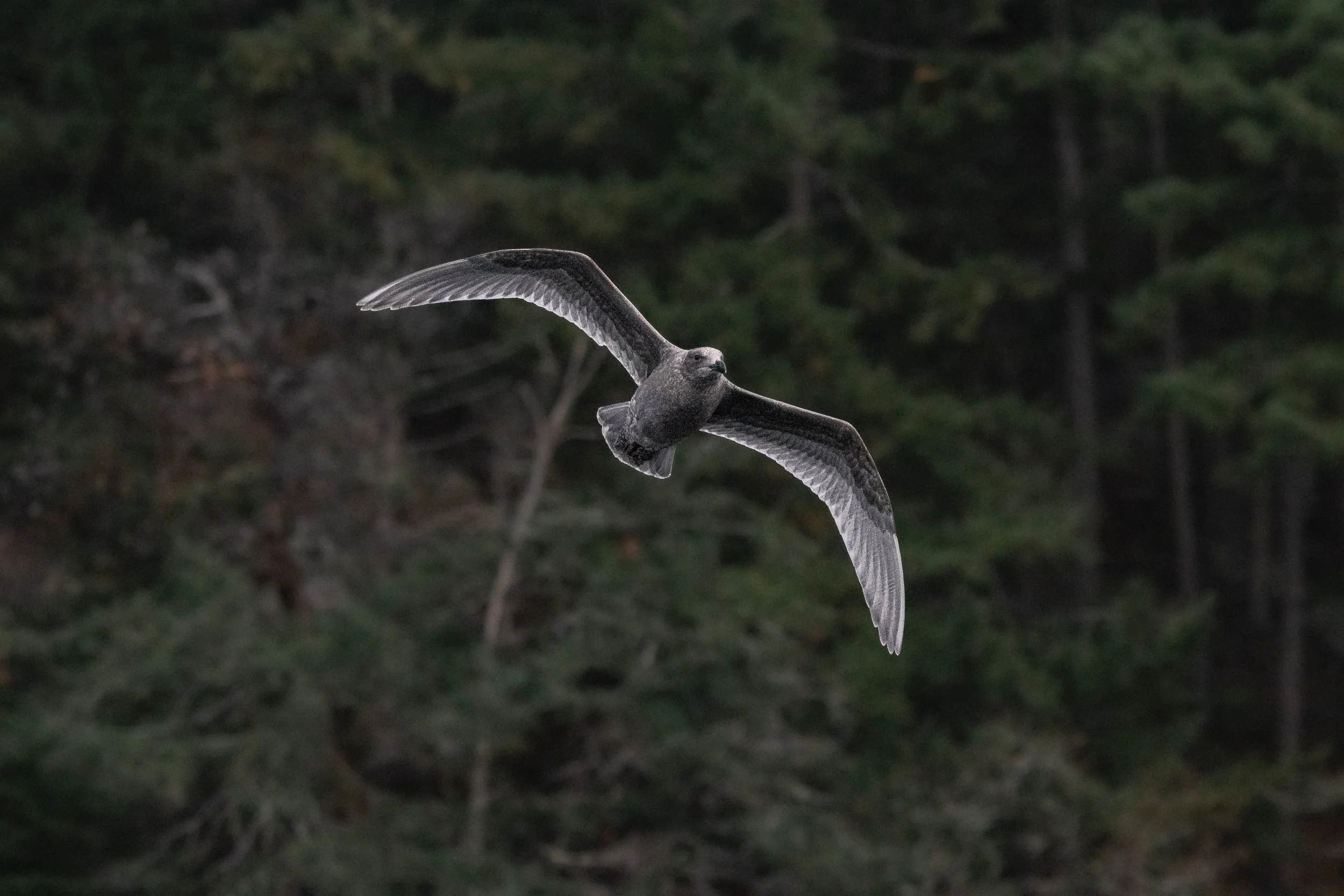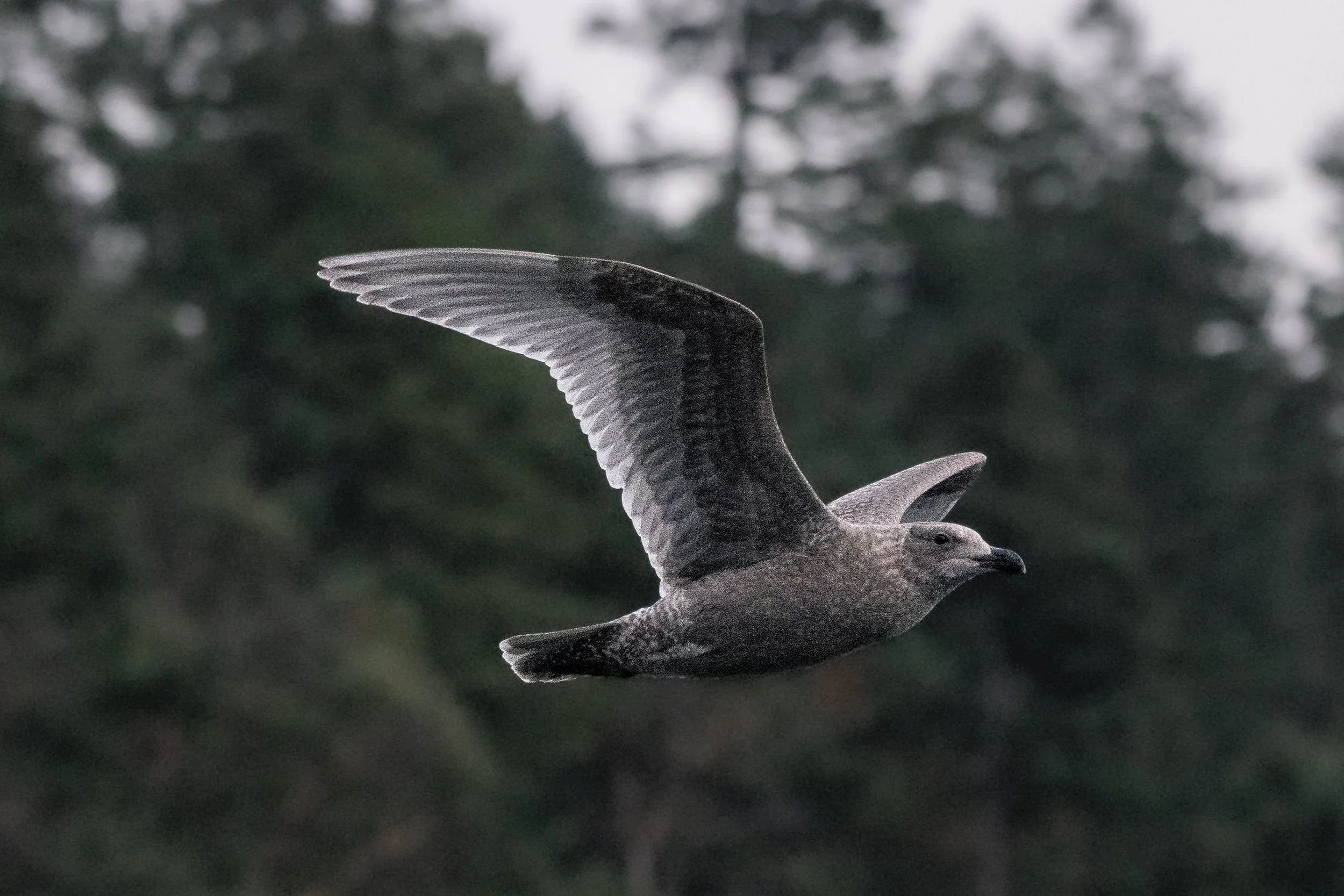November 23, 2025 - Graphite makes a 'splash' outside Porlier Pass with friends!
After getting bundled up and cozy on board our semi-covered vessel, Kula, the trip set off, and began the day’s adventure. Today, they started the trip by heading south, through the Southern Gulf Islands.
Kula crossed through Dodd Narrows, a small waterway outside Nanaimo, and that’s when the search really started! All eyes were scanning the horizon, eager to try and find a blow, fluke, or fin travelling through the waters. Because all of our whales are wild, with no trackers or tags, we never truly know where they will be from day to day. However, the inside waters of the Southern Gulf Islands have been bustling with activity in the last week or so, so it’s always a great place to check on! After briefly stopping near Crofton to peek around for a bit, they continued onward, out into the Strait of Georgia.
The first stop of the day was at “Stinky Rocks”, a well-known haulout. Here, many sea lions rest high up on the rocks, out of the frigid waters of the sea. Stinky Rocks has become very popular for our sea lions in the last couple of years, and it’s easy to see why: Stinky Rocks is a relatively large rocky outcropping, with multiple separated rocks available for them to sleep or rest on. The stones are also tall enough that, even during the highest tides, there typically is still a bit of rock poking out, meaning it is a haulout that is usable at all times of the day. If you rest on a rock that is only above water during low tide, every time the tide comes in, you’d end up getting washed off and needing to find another place to rest, resulting in more calories burned and less time to relax. After watching our sea lions for a bit, they headed out, beginning to search around the open waters of the Strait of Georgia.
The trip took them southbound, to the waters off of Porlier Pass. This area has been packed with humpback sightings lately, and we were eager to try our luck. Peering around, we began searching until we found our first humpbacks of the day: a trio of humpbacks associating and travelling together! After our initial sighting, the team began getting into position, and our onboard Naturalist started working on identifying who they were with. For humpback whales, we usually use the underside of their tail to identify them individually. The ventral side of the flukes has a unique combination of pigmentation, alongside barnacles, scratches, bumps, scrapes, and sometimes notches, resulting in a highly distinctive pattern. With a photo of this, you can compare it to the ID catalogues for the area (for our area, we recommend the Keta Coastal Conservation Catalogue), and figure out who’s who! However, today the whales were being a bit tricky. Two of the individuals were rarely fluking, which can complicate identity confirmation. Thankfully, both of their dorsal fins (the fins on the top edge of their backs) were unique enough to confirm who they were.
The two tail-shy whales were identified as Dandelion (BCY1107) and Scuba (BCY1225). The third individual present was much more cooperative, fluking high, creating many opportunities for a clear ID shot. This whale was identified as Graphite (BCX2077). While the trio was initially travelling together, they soon broke apart, and Scuba and Dandelion continued on their way, with Graphite staying by himself. After the trio split up, Kula continued travelling with Graphite. Soon after that, Graphite excitedly started splashing around, quickly diving and tail lobbing away. These acrobatics are always amazing, mainly because scientists aren’t entirely sure why they do them. Slapping away constantly at the surface consumes a lot of calories, which is the exact opposite of what our humpbacks want to be doing just before their migration starts. Right now, they should be gobbling up as much as they can, getting in their last few meals before they depart, as they will not regularly feed again until they return to our area next summer. So, why would Graphite decide to be slap-happy instead of focusing on conserving energy? The leading theories are that the quick slaps at the surface could help pull debris or parasites off the skin, relieving them of potentially itchy ‘hitchhikers’, or that it could be for communication to call other whales over, to either help group feed on a large school of fish/krill, or to warn other whales of potential dangers. Another reason Graphite could be slapping at the surface with his tail is to stun potential prey, leading to an easier time feeding - though that tends to be shorter slap-sessions than what was witnessed today!
After saying goodbye to Graphite, the trip continued, and soon after that, another trio of humpbacks was spotted! These three, similar to our initial group, were associating and travelling along, occasionally diving and fluking as they went. These three were identified as Two Spot (BCZ0432), YinYang (BCY1058), and Velvet (BCY1186). Two Spot and Velvet have become regulars in our area in recent years, returning every summer to plump up and prepare for the upcoming breeding season. YinYang, however, is a less commonly seen whale. Interestingly, the majority of their sightings are in Mexico, one of the areas where our humpback populations breed. YinYang’s first HappyWhale sighting is from 2005, meaning they are at least 20 years old. With no confirmed calf sightings over 20 years, the chances are high that they are male. We usually expect humpbacks to return with their first calves within the first 7 to 12 years of age.
Not that long ago, it was incredibly rare to see humpbacks associating together. The general consensus used to be that humpbacks were likely solitary animals, spending the majority of their time alone. However, as their populations have increased and begun to recover since the whaling era, that notion has rapidly been dismissed. Now, we often see humpbacks travelling in pairs or trios, and quite often, if you look around you as you travel with one group, you can see more in the distance. We are excited to continue watching our humpback population grow and flourish, and witness new developments as we learn more about how their social structures work!
Soon, it was time to depart from our second group of humpbacks. We quickly headed back through the Southern Gulf Islands, aiming back north towards Nanaimo. Crossing back through Dodd Narrows once more, we began traversing Northumberland Channel. We headed over to some of the log booms situated at the edge of Gabriola Island for one last wildlife viewing - here, a large Bald Eagle was perched on the logs, peeking into the waters below. Our onboard Naturalist pulled out her camera, began snapping some majestic shots of this beautiful bird, until things took a bit of a ‘turn’ - the eagle turned around, and suddenly, projectile defecated, leading to quite the shot that can be seen below! While the whitish waste is often called ‘poop’, it technically is actually feces and urine at the same time! Birds have what is known as a cloaca, or a single opening from which they defecate and urinate. Because of this, they release both at once, leading to the liquid waste we are all too familiar with. If you want to sound fancy, you could also refer to this as a ‘whitewash’, due to its colour!
Wrapping up the trip, Kula and her passengers began heading back into Nanaimo, concluding another excellent and encounter-filled day exploring the Salish Sea!
Please enjoy these action-packed photos by Marine Naturalist Vanessa Vereschahen below!
Nice and cozy in one of the haulout crevices.
Basking in the sun.
A Sea Lion playing in the surf.
Dandelion’s dorsal fin.
Scuba’s dorsal fin.
Graphite’s fluke.
Graphite waving his tail around.
Graphite quickly diving.
The top of Graphite’s fluke.
Graphite’s distinct dorsal fin.
Graphite upside down, with the ventral (bottom) side of his fluke visible.
Graphite tail lobbing.
The underside of Graphite’s flukes and peduncle.
A fluke waterfall off Graphite’s fluke.
A beautiful upside-down arch from Graphite.
Going for another dive!
Splashing away.
Graphite waving his pectoral fin around.
A headstand from Graphite.
A Beautiful Bald Eagle resting on the logs, and then…
Fire in the hole!
Acting like nothing happened.
Take off!
A young Gull flying by.
A closer look at the young Gull.


